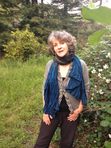Patricia Damery's Blog, page 12
August 17, 2015
Review: A Shepherd’s Life
Books come when you need them. For me, The Shepherd’s Life: Modern Dispatches from an Ancient Landscape, by James Rebanks, is such a book. Rebanks is the descendent of an ancient generational lineage of shepherds in the Lake District of Northern England. He writes about his childhood growing up as the inheritor of the tradition of shepherding and about how he has grown to take up the modern challenges of the mantel himself. His writing is pithy yet descriptive, a story with a larger tale.
Much of the book is place-centered: the practices of being a shepherd, the taxing demands of the mountains, and the importance of the fabric of family and community. But it also depicts an archetypal pattern that has developed over the two centuries of major immigration. What happens to us when we move from place to place? What happens to our feeling about the land we live on? When my husband and I visited his mother’s family in Germany, we were told that another family was newcomers, they had only been there 300 years!
Rebanks knows his land, some of which is common land, something we do not understand in United States. “This is an ancient, hard-earned, local kind of freedom that was stolen from people elsewhere,” he writes of the commons and of shepherding. “The kind of freedom that the nineteenth-century peasant poet John Clare wrote about. He lamented the changes in the Northamptonshire landscape he loved because of the enclosure. He saw the disconnection that was being created between people like him and the land, something that has gotten worse with each passing year since then. … ours is a rooted and local kind of freedom tied to working common land, the freedom of the commoner, a community-based relationship with the land. By remaining in a place, working on it, and paying my dues, I am entitled to a share of its commonwealth (p.286).”
Contrast this to our current value of private property rights, a “right” that is beginning to be reconsidered in the drought and water issues in California. We are discovering that we are interconnected. Dwindling resources of land and water force the issue. The attitude of Rebanks of a serving a larger purpose is gone. “I have always liked the feeling of carrying on something bigger than me, something that stretches back through other hands and other eyes into the depths of time. To work there [in the mountains] is a humbling thing, the opposite of conquering a mountain…(p.286).
Does the concept of private property and of financial return on that private property, serve the ego’s agendas of self interests, and open space and the commons serve a larger, collective Self (C. G. Jung)? I suspect so. Certainly First People’s relationship with the earth was much more of that of the commons. When white man arrived, private property rights eclipsed territorial designations within the commons— and the environmental and social destruction began.
It is time we seriously rethink our relationship to land. The Shepherd’s Life is a stimulus and a guidebook in so doing, at once locally based with universal truths.
The post Review: A Shepherd’s Life appeared first on Patricia Damery.
August 11, 2015
August: The Fifth Season
In California, August is a kind of fallow month. The following excerpt from Farming Soul: A Tale of Initiation tells why:
Ash and the Fifth Season
In the Mediterranean-like climate of the Napa Valley, there is a period of summer dormancy that has is often called the fifth season. The grasses are dry and golden; the grapes in veraison but not yet ripe; and the lavender pruned into green mounds that will look this way until they send up stems late next spring. There is not much to do but think.
It was in August that Donald sustained what we thought was a back injury. We expected it to get better in a day or two, but instead the pain kept him awake for several nights running. He could no longer cut firewood or even lift the chainsaw. Natalio carried the recycling to the road and buckets of water to the goats on the evenings when I wasn’t available to do it.
Donald’s back kept getting worse, not better. His legs eventually became numb and his ankles swelled, the skin breaking. He lost his balance easily. Frightened by these strange symptoms, we visited various practitioners and received various opinions and treatment suggestions. We tried different things, but his condition would improve one day and get worse the next.
A darkening happened in my world. The ash of my parents reverberated in my body and I listened: Life is not forever. Donald and I are aging. We, too, will die. And I heard the question: Who will farm this land next?
When you farm biodynamically, this is a complicated question. You have made a promise to the land in using the biodynamic sprays, and the land and plants have become more sensitive to your thoughts and intention. To return the land to chemical farming methods is a betrayal. Donald and I were contemplating not only our own mortality, but the “death” of integrative farming practices on our beloved ranch.
* * *
Ash, according to the alchemists, is a substance from which the impurities have been burned off and which can be subjected to further processes to form the Philosopher’s Stone, the Stone esoteric circles call the subtle body or diamond body and Christians have named the glorified body. It is this part of us that survives the death of our physical and, therefore, corruptible bodies. Jung stated that the formation of this so-called body is our task during the second half of our lives.
Myth tells us that Zeus punished the Titans for eating the infant Dionysus by striking them with a lightning bolt, thereby reducing them to ash. Within this ash were particles of the divine infant, that symbol of the generative life force, and from them the human race was formed.
Do I carry the divinity of my parents within my own body? Does something of their individuality linger? What intimacy has been wrought upon me! I listen inwardly again and hear my father’s voice this time, saying: Let Jesse farm.
* * *
My father died on an August day in 2004, just before harvest. On that same day in August, but one hundred years earlier, my great-grandfather also died just before harvest. So in this month particularly, the house my great grandfather built in central Illinois and in which the family has lived continuously ever since, reverberates with disincarnate relatives. To me, the upstairs master bedroom is so loud with lights that it could be the Fourth of July.
And the smell! It is uniquely musty and otherworldly, occurring in certain spots in the master bedroom of the old family house and once in my own home after I returned from my mother’s memorial. As she was dying, I asked her to let me know she was okay when she got to the Other Side, and she said she would if she could. And she did, by surrounding me with the scent of the old Illinois homestead in my California kitchen!
It used to feel to my siblings and me like the dead were loitering eerily in their old haunts, but now their presence reassures us, their successors. Life and death are mysterious. The dead are all around, and their distinctive scent reminds my family of this. We call it the smell of the ancestors.
Our sense of smell comes from one of the oldest parts of our brains, and we mammals are what naturalist Lyall Watson calls “supersmellers.” We are also scent factories, besting even the flowers with the odors our warm bodies exude. We each have a unique olfactory signature that bloodhounds can readily identify, days and even months after we have been physically present in a particular place.
We slough off forty million cells a day, some drying up, some persisting for possibly centuries. As a result, we all live in an invisible sea of such cells, the Divinity of Dionysus dancing among us and through us with every breath, collecting more of himself as he goes!
Is this the akashic record from which Norma T. claimed to “read” details of past lives, or the vast expanse of Jung’s collective unconscious? And is it some ancient part of our brains, with its potent ability to perceive odors, that informs us of these “matters”?
* * *
It took some time before an EKG revealed that Donald had suffered a silent heart attack. He embarked on a new exercise and diet regime and finally controlled his blood pressure with medication. It appears we have been given more time together.
Every August, though, I can’t help but contemplate life and death, the seen and unseen, and the pervasive presence of ash.
Watson, p.215.
The post August: The Fifth Season appeared first on Patricia Damery.
August 3, 2015
Eating Locally
You would have thought I had just brewed a poison tea. Half of my writing group scoffed at the Douglas fir tea that I had just made. I had picked the tender fir tips from several young trees on our walk earlier, committed to having at least one item from the retreat land where our writers’ group meets each month. The house, which we affectionately call Castle Keep, is on the site of an old stagecoach stop, located down a quarter mile driveway. The orchard along this driveway has been abandoned, and much of the 30 acres of the property is overgrown with blackberries, poison oak, a succession of oak trees, and many other of the natives that also grew here when the Pomo camped along the creek. Its main inhabitants are coyotes, deer, and bobcat.
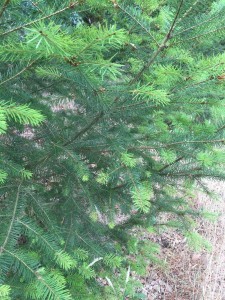
Tender tips of Douglas Fir used for tea.
Okay, so one of the teas I brewed last summer caused one of our members to have an allergic reaction. Aren’t we all allergic to something? I can’t even remember what plant I used for that tea. I think it was of the mustard family. But after that, my beloved fellow writers (and most of us have been together 35 years) are suspicious. I try to tell them: it is important to commune with the energy here each time by eating something that grows here. Throughout the spring, there is ample miner’s lettuce for salads. In the summer there is Douglas fir tea and blackberries. In the fall there are numerous apples from the abandoned orchard and lemons from an old tree just east of the house. The winter too offers lemons and other plants for teas. There is always an abundance of nurturance and healing offered by that which grows in the soil where we stay, cultivated and native— both.
I always feel eating local weaves me into the energy of a place, alerts me to who also is there. It sensitives me to the symphonic energies of the Other, synchronizing me to the spot.
But I do accept that not everyone feels this way!
(Check out the recipe: Eat Locally Grown Plants)
The post Eating Locally appeared first on Patricia Damery.
July 24, 2015
Forest Buddha
The Forest Buddha sits just outside the gate on the western most reach of the vineyard and lavender field (Lot Sophia). Each day I walk the goats, we pass the Buddha. He amplifies a quiet place in my soul, reminding me of why I am on earth. The goats remind me, too, in their much more kinetic way! There is such beauty in the present.
My son Jesse gave me a card prefaced with a quote from Thich Nhat Hanh: “Let us offer each other happiness and establish ourselves in the present moment. We should let go of our sorrow and embrace life in our two arms.”
In this time of such climate shift and uncertainty, it is more important than ever to “let go of our sorrow and embrace life with our two arms.” The Buddha and the goats help with this. The Buddha serves serenity. This fifth season of summer fallowness in our Mediterranean climate finds him surrounded by dried oak leaves, so close to the driveway, yet also sequestered away. When I first set him in his spot, our llama Rocu was the first to notice him, and he noticed on the first walk-by. No one else saw the Buddha for weeks. You have to slow down to see him, to move into that state of mind that sees what is there, not what you think is there. Oddly, even some people who know he is there have trouble seeing him until he is specifically pointed out. We see what we expect to.
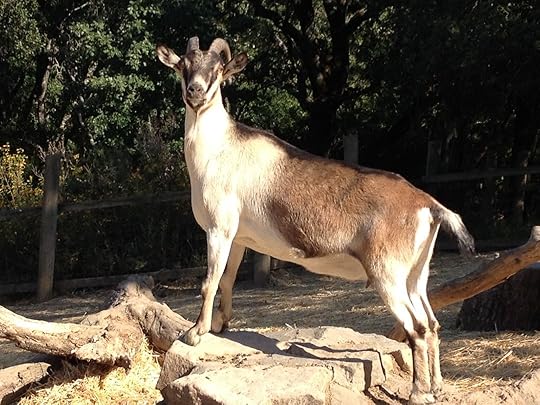
Agaleah: Buddha in goat body.
The goats help by insisting I stay in the present and see. As a friend commented when he saw pictures of our horned beauties, “They look dangerous!” The truth is, if you aren’t paying attention, they are dangerous! They gleefully gamble down the path, accidentally knocking you with their horns if you are not careful. Once Agaleah broadsided me. She was very sorry, returning and leaning against me as I picked myself up, but honestly, it was my fault. I wasn’t paying attention to my place in the whole herd. Maybe having a goat broadside you is a little like a whack by a zen master!
The post Forest Buddha appeared first on Patricia Damery.
July 18, 2015
Old Friends
The Psychological Perspectives issue with my article about the death of a beloved valley oak on our ranch, “When an Old Friend Dies,” had come in the mail the day before. As I sat down to look at the article in print, the phone rang. “I am not sure that you know, but Mary Jo died yesterday morning,” my friend Michael said.
Mary Jo was 100 years old, so this should not have been a surprise, but it was. I immediately remembered the summer day years ago when Mary Jo visited our ranch. Even then she was old, but she wanted to see the beautiful valley oaks that were grafted together in the meadow next to our home, ancient and mysterious, and so her caretaker brought her. Although the day was 100°, she insisted we walk the quarter mile to the knoll where they grew. The goats came with us, and the llama, and Donald followed her with a chair in case she needed to sit. She was still vibrant, even in her early 90’s. We warned her of the stickers in the tall, golden grass, and she simply said, “I will sacrifice a pair of stockings.”
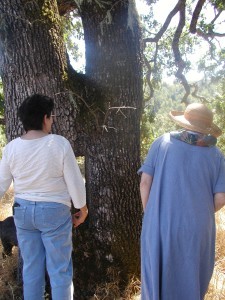
The grafted valley oaks. Mary Jo on the right.
She had been an important mentor through some difficult times for me, having been one of two control analysts in my training. When the other died unexpectedly, she had called me within an hour of the news: “I will help you,” she said. “I am here with you.”
And she was, guiding me with her wisdom and her confrontation, with her confidence and her love. After my certification, a small group of us women analysts met with her, reading The Secret of the Golden Flower, and discussing life. We began this reading group with a personal tour of a Taoist art exhibit at the Asian Art Museum in San Francisco, led by Mary Jo, a docent there, perhaps the oldest. I write about this experience and a dream that preceded it in two blogs, “A Big Dream” and “Another Elder Story“.
She traveled extensively, and to China more times than you can count on both hands. She toured Iran during the time of the Iraq war, and after the walk to the valley oaks. She told me once that she spent days at Chartres Cathedral studying the Rose Window.
But death and aging cannot be cheated. After Iran, she did not travel again. She lived in a multilevel home with many stairs, something that scared us all as she became increasingly unstable. As she lost her eye sight, several signed up to read and study the books that she loved, a rich experience for many of us.
Late in my time with her I responded to her need to get a cat by taking her to the Human Society —at her insistence. Not only did she get a cat, she got two, and fiercely confronted the personnel when they suggested that two kittens at her age when she was legally blind was inappropriate. She pounded her fist on the counter, demanding the kittens, and for whatever reason, they let her have them. There are people who cursed me for my part in this, as the kittens climbed her curtains and shredded her furniture.
My relationship with Mary Jo ended in the way mentor relationships sometimes do: roughly. Although the details are ones that I hold private, suffice it to say that I experienced the darker side of a woman that I had revered. Perhaps age pushes psychological complexes; diminishing capacity and health issues humble us. There is so much unknown as we lose abilities and faculties that we have defined ourselves with through the years. And then, the end of any long training relationship is often a shock when one looks behind the screen to discover that the idealized image is different from the human being.
These last years it was hard for me to place where I was with her. At the time of her death, I had not seen her in two years. Nothing that had happened changed the value of what I received from her, but at the same time, I did not know how to hold her in my heart.
But the synchronicity of the arrival of “When an Old Friend Dies” and the call telling me of Mary Jo’s death brought a warmth. I like to think she moved through in that synchronicity, because I felt my heart open in gratitude and love to have known the breadth of her. I wish her well on this last journey. Safe passage, Mary Jo!
The post Old Friends appeared first on Patricia Damery.
July 8, 2015
Dark side of Travel and Tourism
I love to travel. I have from as far back as I can remember. One of my favorite poems as a child was, Monday’s child is fair of face, Tuesday’s child is full of grace, Wednesday’s child is full of woe, Thursday’s child has far to go…
I was born on a Thursday. I had my mother read this poem over and over to me. Even then I loved our family trips. Each summer my mother insisted we travel, something uncommon for many farm families at that time. I remember being hungry for the sight of a body of water that you could not see across (and that was Lake Michigan, when I was 9) and a mountain, which was the Smokies, when I was 11 (and the sight frightened me. What if it fell?)
When I was 21, my mother gave me a porcelain figurine of Thursday’s child holding a back pack and a sign, “This child has far to go.” It was not long after this that I packed my car with every possession I owned and moved to California. I drove through the Rockies, the western most known place in my world and drove on through the high country of western Colorado, the salt flats of Utah, into the blue plains of Nevada. By the time I reached the red soils of the Sierra, and descended into the Valley and on to the coastal range of northern California, my soul had embraced the West and I knew I could never move back.
But I also continue to crave travel. It is as if, as rooted as my soul is in the soil of our ranch, it requires the larger perspective of where we are on the planet. I count visitations like beads on a rosary: the first time we flew over Spain and on into Rome, the first time we flew over the pole and saw the midnight sun illuminating snowy mountains of Greenland, the first time I saw the isle of Ireland from the air! I am continually feeling a place in comparison with that upon which I live.
And yet I have to question this passion of mine to experience the totality of our planet. What is the impact of travel on our climate? High altitude flying produces carbon emissions that are profoundly impacting our atmosphere and contributing big time to climate change. Train travel is much more planet friendly, producing about 1% of the carbon emissions of airline travel.
What is this compulsion to see the world? Again, I return to childhood: my mother’s family lived in the city. Her father was a successful commercial artist, and her family traveled whenever possible, traveling by train from central Illinois to the West Coast shortly after the First World War, driving to the top of Pike’s Peak when the road first made it accessible by Model T, and thoroughly exploring Appalachia with my then young mother. On the other hand, my father’s family farmed. His mother left the state of Illinois twice, once to visit her grandmother in Ohio when she was in her late teens, and once to Missouri when I was a young girl. Both times she became so homesick she never wanted to leave the state, and probably, our Macon County! again.
I have an image as a two or three year old child of standing between both my grandmothers and holding them by their skirts. Probably I was being doted upon! I remember saying, “Two Mee-maws!” It is a memory I carry to this day. I was a bridge between my mother and father, between the city and the country, between loving travel and loving homeland.
In Napa County, California, we are becoming as overrun by tourists whose primary draw is said to be the beauty of the Valley as we are by dependence on their dollars. Focus has become how to draw even more tourists, and to extract as much money from them as possible. In the next blogs I will focus on this phenomenon which is occurring worldwide: a transition into a tourist economy. It is a trend that undermines the integrity of community, making it difficult or impossible for the children of locals and service providers to afford to live in the community. As venture capitalists move in and wealthy families buy up attractive land for second homes, inflating property values, the social and ecological health of the community suffers. It becomes less about community and more about profit.
I am well aware of my contribution to this tourist economy in my travels, whether that be in Ireland or Spain, in San Francisco or even in my home of Napa County. But how do we work to support healthy economies and social structures in such places that others also want to experience? What is it we are really searching for as tourists? And how do we balance that with the health of the community and the land under our feet?
The post Dark side of Travel and Tourism appeared first on Patricia Damery.
July 1, 2015
Death of Tree
“When an Old Friend Dies” was just published in the June issue of Psychological Perspectives. The article details an experience my husband and I had when an ancient valley oak fell last year. It is a tree we both loved. It grew next to a little pioneer farmhouse that we lived in while we built our current home. The tree itself was home to colonies of bees, to mourning doves and acorn woodpeckers, and, annoyingly, to a mockingbird who liked to sing her repertoire in the early hours of hot summer nights. A small shed had been built by the tree about 160 years ago, and this shed was probably the agent of the tree’s early demise. We mourned the tree, and in that mourning, used some of the biodynamic principles to make a preparation that has been very beneficial in this fourth year of severe drought in California. (See Making Barrel Compost, and Barrel Compost and Drought).
The article is a eulogy of sorts, but it is also a suggestion of the evolutionary possibilities of our times. The tree is a living entity. Goethe says it is an expression of a Being behind it. Relating to these Beings that live around us and that we so easily exploit necessitates an evolution of consciousness, one suggested in the story of the Fall from Paradise. This is critically important in our current crisis: Nature has needs and agendas of her own. She is not just here for our benefit, to be extracted from, but rather, to be related to. Or, as philosopher Dennis Klocek puts it, “The great theological question for millennia has been that, since nature has been separated from the divine by the Fall of the human from paradise, is the divine still present in nature as we experience it as human beings?”
You can access this article for free (at least, the first 50 people can!) at this link: Psychological Perspectives. Acknowledging spirit in matter is a rich experience, one that has helped us with our ranch and our farming, and perhaps can help us with our climate crisis.
The post Death of Tree appeared first on Patricia Damery.
June 24, 2015
On Being Grounded
What is being “grounded”… a term so often used these days? “She is not very grounded.” “I need to get grounded.” We often use it to talk about people who are flighty or “not in their bodies”. But what does that mean?
I received an “embodied” answer yesterday. I consulted a psychic about a situation. (Yes, in fact, I do consult psychics occasionally. In fact, my spiritual teacher was characterized as a psychic.) I had consulted her several months before when she had cautioned me to rest and have more time off, which I have done.
Yesterday I tried to scheduled the appointment on line, wishing for an immediate phone appointment and also realizing this was probably impossible. In fact, I was relieved to see openings later in the week. When I attempted to schedule one of these times, I was surprised to see the appointment was made for three hours later! I immediately felt the presence of what my spiritual teacher termed called “guides and teachers”. This was not a coincidence, and I let myself feel that.
When the psychic answered the phone for my appointment, she immediately said, “you are so much more grounded than last time! You are in contact with your guides and teachers!” The appointment continued, and I got helpful information, but this statement was perhaps the most important of all.
At first it seems paradoxical: how can being in touch with the realm of spirit be “being grounded”? And yet, I also know how much more grounded I feel when I attend to these matters of spirit, of spirit in matter. I feel most grounded when I have meditated; when I walk with my goats, which requires immediate attention to the present; when I simply sit and take in the beauty of my garden. I feel grounded when I weed lavender for hours, and my mind gives up thought.
Neuroscience helps to understand the state of being grounded. (For more on this, see Dowsing and Evolution of Consciousness) The brainwave threshold of alpha (relaxation) and theta (the state reached in dreams or hypnosis, associated with the subconscious), about 7.8 hertz, is also the resonance of the earth. When we are in that state, we are in resonance with the earth, grounded. We experience a feeling of at-onement and are open to banks of information that are not available in our everyday consciousness. This includes subconscious material as well as, perhaps, contact with presences that are not us, the land, a tree, spirit!
And as C. G. Jung said, “Sometimes a tree can tell you more than can be read in a book.” Perhaps for our well being and groundedness, it is time we learn to listen.
The post On Being Grounded appeared first on Patricia Damery.
June 10, 2015
Goats as Psychopomps!
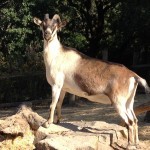
Agaleah on her rock.

Agaleah celebrated!
Animals act as psychopomps between the worlds in dreams and everyday life. How many of us have a beloved cat or dog whose warm, soft body reminds us that we too are animals? My husband and I have two cheerful yellow labs, siblings, who have been with us for almost 12 years. Tending to their needs for exercise and affection and receiving their unflagging loyalty humanizes us, brings us to earth.
But we also have a small herd of goats who walk with me almost daily. We have had goats for 20 years. The original pygmies, of course, are on the other side. Natalie and Boris were the first. I was shocked at how much their presence grabbed my heart and soul. They taught me the way to walk forest trails, paying attention to the scolding of birds and squirrels, and that it is important to enjoy the sun and the slant of hillside grass (which you slide down on on your belly, if you are a pygmy). They showed me that domestic animals have made a sacrifice to live with us, and that some of them are also on an individuating path.
These days graceful, long-legged alpines click horns in bouts of dominance decisions in the goat pen. Goats have been surprising muses for me, sharing a wall in my writing studio. When I walk, it is with this rambunctious herd of beauties who are almost deer, as well as with the llama who guards them, but I still feel the unseen presences of Natalie and Boris and the rest of the gang, all these beings who initiated me into goat-dom.
Yesterday a box arrived on our doorstep from Guanajuato, Mexico, with twelve ceramic plates memorializing the dead and celebrating the living of this herd. My friend Dianne introduced me to the potter Gorky and to Gorky’s family when I visited her and her husband in April. Years before she had given me a lovely ceramic bowl of his which had broken. I wanted to replace it.
Once at their shop, I realized that I wanted plates with goats on them, and although they were out of plates with goat images, they offered to paint my goats on plates if I sent pictures of the goats.
Which I did! What I love is that the plates themselves are both mythic and absolutely concrete. I recognize each goat and llama from his or her image: Ah! here is that expression that can be only Agaleah! and twist and tension in the body of Boey! and here is Natalie, and Libra, and Hijo (the llama), and Petunia! They infuse the food we eat from the plates with this liveliness of food of spirit, of life of the imagination, and the absolute beauty of our earth.
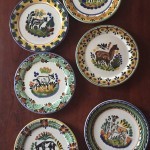
More of the herd.
The post Goats as Psychopomps! appeared first on Patricia Damery.
June 8, 2015
APAC: Nature Holds the Final Card
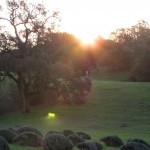
An historic oak savanna: will it get the protection it needs?
Comments to the Agricultural Protection Advisory Committee, APAC, on June 8, 2015
I am Patricia Damery, and I live at 3185 Dry Creek Road, in Napa County, where my husband and I are growers. I am also a Jungian psychoanalyst in private practice here in Napa. I want to read a quote from the psychiatrist and philosopher C. G. Jung, who wrote a great deal about balance with nature, whether that nature be our inner nature, the lion’s share of my work with patients, or the natural world— the lion’s share of our work in farming.
Jung stated,
The facts of nature cannot in the long run be violated. Penetrating and seeping through everything like water, they will undermine any system that fails to take them into account.
If we fail to put first the facts of nature—the needs of a healthy environment— everything is undermined, including the economics of our Valley. Yet who will advocate for Nature? Director Morrison, as you so eloquently pointed out at the CEQA workshop on Saturday, CEQA, while an important and groundbreaking process, is not that advocate. As that ad on NPR says, Nature needs an attorney.
But, potentially, Nature has you, APAC. That’s how this all got started. You are in an unprecedented position of advising the Board of Supervisors, which does have the power to act on behalf of Nature. If we continue with the status quo, letting money drive the machine, as it appears to be doing now, the result will be the further commercialization of our watersheds and result in further environmental degradation.
One recommendation to this end is to make the Oak Woodland Management Plan, already a part of the General Plan [of Napa County], mandatory, not voluntary, as it is now. If we allow economic and business interests and fine wines to trump our fine forests and oak woodlands, Nature will hold the final cards. We need your bold leadership that goes against business as usual. I ask you to make those bold recommendations to the people who can implement them.
The post APAC: Nature Holds the Final Card appeared first on Patricia Damery.

